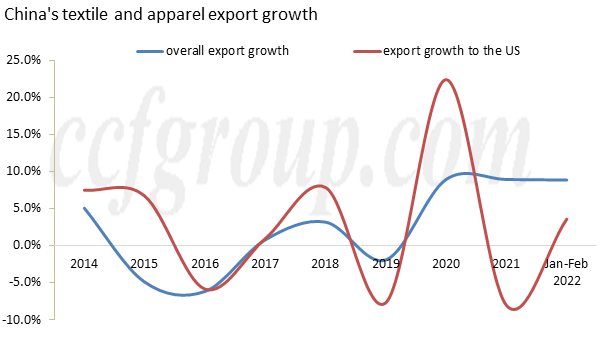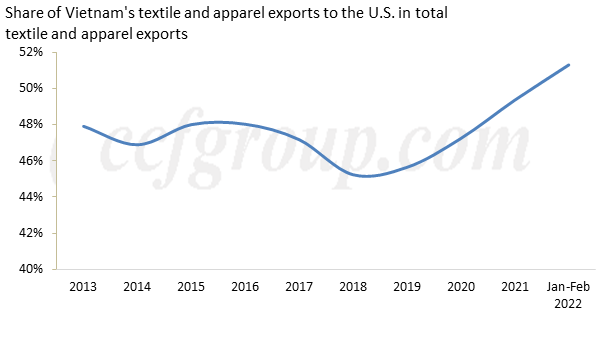Sino-US trade war speeded up the transfer of textile and apparel orders
1. China's textile and apparel exports had showed growth before 2020, but the share of the exports to the United States decreased significantly in 2020, and the growth rate of exports to the United States was slower than the total growth rate in the past three years.
2. Since the Sino-US trade war, the proportion of Vietnamese textile and apparel exports to the United States has increased year by year, and the export growth rate was faster than the total.
3. Vietnam's share in the US textile and apparel market has been on the rise in recent years, and the Sino-US trade war and U.S. ban on Xinjiang cotton have accelerated the transfer process.
China's textile and apparel exports are still growing, but the share of exports to the United States decreased significantly last year. Before 2018, the share of China's textile and apparel exports to the United States grew steadily. With the beginning of the Sino-US trade war in 2018, some orders were ahead of schedule. On the contrary, the exports to the United States increased rather than decreased. With the outbreak of the COVID-19 pandemic in 2020, the contribution of China's epidemic prevention textile and apparel exports increased greatly, and the market share of the exports to the United States reached a new high, accounting for 18.7%. With the normalization of the epidemic last year, the contribution of China's epidemic prevention textile and apparel decreased. And the recovery of major textile and apparel bases has also led to the transfer of some orders from China, so China's market share of exports to the United States in 2020 reached a low of 15.8% in recent years.

From the comparison of the growth rate of China's textile and apparel exports with that of exports to the United States, the latter has been faster than that the former from 2013 to 2018. After the beginning of the trade war, the growth rate of China's exports to the United States began to be frequently slower than that of total exports (2020 except). China's textile and apparel export growth market was no longer the United States, and then to other markets, especially the gradual growth of textile exports. China's textile and apparel export orders have been affected to a certain extent since the Sino-US trade war in 2018, especially the transfer of cotton products orders was more obvious. The orders were mainly shifted to Southeast Asia (especially Vietnam), India and Bangladesh.
Share of Vietnam's textile and apparel exports to the U.S. has been increasing since 2018
From Vietnam's textile and apparel exports and the exports to the United States in recent years, the Vietnam's textile and apparel has indeed showed upward trends.

![U$AOQU(E8%D86@MZRI2]]2P.png U$AOQU(E8%D86@MZRI2]]2P.png](https://pic.ccf.com.cn/2022/04/2022041309430385.png)
The share of Vietnam' s textile and apparel exports to the United States fluctuated before the trade war, but after the trade war began, the proportion of Vietnam' s textile and apparel exports to the United States increased year by year from 2019 to 2021, rising to 49.4% last year, and 51.3% in Jan-Feb this year. As for growth rate, the growth rate of Vietnam' s textile and apparel exports from 2013 to 2018 was faster than that of the exports to the United States, while from 2019 to 2021, the growth rate of the Vietnam' s textile and apparel exports to the United States was significantly faster than that of total exports, which showed that the contribution of Vietnam' s textile and apparel exports to the United States was greater than the average in the last three years. From the perspective of US textile and apparel imports, Vietnam has always been the second largest US textile and apparel import source besides China, and its market share has also gradually increased in recent years. The Sino-US trade war and U.S. ban on Xinjiang cotton only accelerated the process of the transfer of American orders.
- Top keywords
- Cotton Price
- Cotton Futures Price
- Cotton Futures
- CZCE
- PTA Futures Price
- Chemical Fiber
- Polyester Prices
- Wool price
- PTA Futures
- Shengze Silk
- China
- Yarn Price
- price
- China Textile City
- Fibre Price
- Benzene Price
- Cotton
- Index
- Cotton Index
- PTA
- fabric price
- NYMEX
- Top 10
- textile industry
- Spot Cotton
- Cotton Yarn
- Polyester Price
- Futures
- PTA Price
- cotton yarn price

